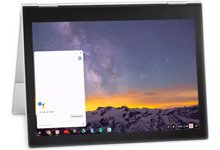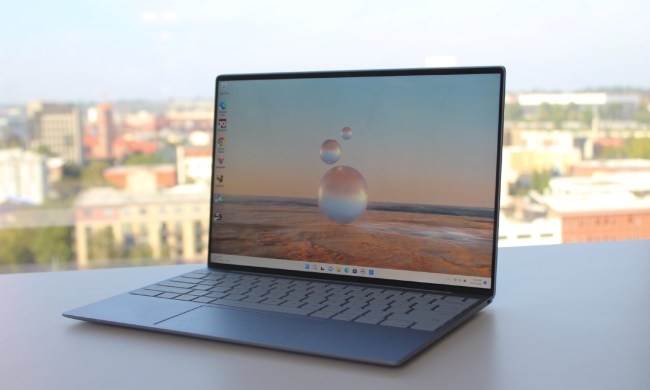
In this comparison, we’ll take a look at everything from the internal hardware, to the advanced feature sets and pricing of both brands of laptop, to see which one is the best.
Specifications
|
Google Pixelbook |
Dell XPS 13  |
|
| Dimensions | 11.4 x 8.7 x 0.4 (in) | 11.98 × 7.88 × 0.60 (in) |
| Weight | 2.4 pounds | 2.7 pounds non-touch display; 2.9 pounds touch display |
| Processor | 7th-generation Intel Core i5 or i7 | 7th-generation Intel Core i3 or i5, or 8th generation Intel Core i7 |
| RAM | 8GB or 16GB | 4, 8 or 16GB RAM |
| Display | 12.3-inch LCD IPS display | 13.3-inch IPS display |
| Resolution | 2,400 x 1,600 | Full HD (1,920 x 1,080) QHD+ (3,200 x 1,800) |
| Storage | 128GB, 256GB, 512GB SSD, 512GB (NVME) | 256GB, 512GB, 1TB SSD |
| Wireless connectivity | 802.11ac, Bluetooth 4.2 | 802.11ac, Bluetooth 4.1 |
| Ports | 2 x USB 3.1-C, 3.5mm headset | 2x USB 3.0 Type-A, 1x USB 3.1 Type C with Thunderbolt 3, SD card reader, 3.5mm headset |
| Webcam | 720P webcam | 720p HD |
| Operating System | Chrome OS | Windows 10 Home or Pro |
| Battery | 41 watt-hour | 60 watt-hours |
| Price | $1,000+ | $800+ |
| Availability | On sale – most models | On sale |
| Review | Hands-on | 4.5 out of 5 stars (last-generation) |
Design
Google took some bold steps with the Pixelbook, emulating its Pixel smartphone design in a notebook format. Although predominantly aluminum, part of the chassis is made from glass, which not only makes it feel like the smartphone, but improves the wireless connectivity, too.
Its bezel is chunkier than some of its contemporaries — Google claims this is to aid in converting it into tablet mode — but it’s still very thin and lightweight. It’s thinner than the XPS 13 by a noticeable margin. It’s lighter too, although only by .3 pounds when compared with the non-touch XPS 13.
Dell’s XPS 13 is somewhat of a classic design at this point, even if it is iterated upon each generation. The latest one has the thin bezels we’ve come to expect from it, holding in the slightly larger 13.3 inch display. It’s built using a combination of aluminum and carbon fiber which helps keep the weight down.
It’s not quite enough to make it lighter than Google’s offering, however. The XPS 13 is also a little thicker, though neither laptop could be considered hefty.
With two laptops matched so closely in terms of portability and premium building materials, it’s hard to definitively say one is better than the other. While we do like the thinner bezel offered by the Dell XPS 13, the Pixelbook’s slightly smaller footprint and weight cut give it the edge in this category.
Winner: Google Pixelbook
Performance
We’ll need to get a full review of the Pixelbook under our belt before we give you the real low-down on how it performs. However, by taking a look at the raw hardware under the hood of each of these laptops, we can get a good idea how capable they should be compared to one another.
Dell’s range of XPS 13 laptops come with varied hardware configurations depending on what you’re willing to spend. At the low-end, it offers Core i3 and i5 CPUs from Intel’s 7th generation of processors, specifically the i3-7100U and i5-7200U. At the higher-end, it offers chips from the new Intel 8th generation, specifically the Core i7-8550U quad-core.
Memory wise it offers between 4GB and 16GB of LPDDR3, and up to 1TB of solid-state storage space.
In comparison, Google’s Pixelbook has a slightly more limited hardware range. Although it too has several different options, it eschews the option of a Core i3 processor, offering in its most basic configuration a 7th-generation Core i5 CPU. It doesn’t name what chip specifically, though we do know that the top end features a Core i7 CPU of the 7th-generation. There’s no 8th-generation processor option at this time.
In terms of memory, you have a choice of 8GB or 16GB of RAM of an unspecified type, and up to 512GB of solid state storage.
Although the Pixelbook is likely to be the faster of the two systems at the low-end thanks to its use of a Core i5 (over an i3) processor, the XPS 13’s support for Intel 8th generation CPUs at the top end could make a big difference. While it’s possible that the use of Windows 10 on Dell’s systems might mean it lags a little behind the Pixelbook’s Chrome OS environment, in terms of hardware potential, the XPS 13 takes the lead.
Winner: Dell XPS 13
Keyboard, mouse, pen and assistant
A laptop is only as good as the ways in which you can interact with it, and both the Dell XPS 13 and Pixelbook offer a variety of methods. You’ll need to pay to have a touch-enabled XPS 13, but the option to tap away on your device is there for both offerings. However, only Pixelbook allows the display to swing back 360 degrees, converting the laptop into a tablet.
Both also offer backlit keyboards, though the Pixelbook’s 0.8mm travel distance is less than the Dell laptop’s 1.6mm, which may give an edge to the Dell. In our hands-on with the Pixelbook, we noted its keyboard was comfortable to use.
The touchpads on both notebooks feature a glass surface and precision inputs, though it’s the Pixelbook’s optional ($100) Pen that might help the Google machine stand out. Said to offer as many as 2,000 different levels of pressure, it has the potential to be a great tool for artists. The Pixelbook also has palm-rejection technology, so you can lean on the screen while using the Pen, and it won’t impact what you’re doing.

Another area where the Pixelbook stands out is the inclusion of Google’s “Assistant.” Using your voice, or the specific Assistant key on the keyboard, you can call up the Assistant, which can give you information about what’s on your screen. This is further improved with the Pen, as you can circle content you’d like to learn more about and ask the Assistant to find it for you, removing steps you might otherwise take to search for it yourself.
The Pixelbook’s extra pen support, 2-in-1 form factor, and Assistant function gives it an edge of the more traditional XPS 13.
Winner: Google Pixelbook
Connectivity
Even though both laptops in this comparison are small, Dell packs quite a few more portsinto the XPS 13’s chassis. It comes with a pair of USB 3.0 ports, a USB 3.1 USB-C with Thunderbolt 3 connector, an SD card reader, and a headset jack. Wirelessly, it supports the latest 802.11ac Wi-Fi standard, and Bluetooth 4.1.
In comparison, the Pixelbook has a pair of USB 3.1 USB-C ports and a headphone jack. Wirelessly, it also supports 802.11ac Wi-Fi and Bluetooth 4.2, giving it a slight edge over the XPS 13 in that regard.
While the Pixelbook’s USB-C is forward thinking, it leaves Type-A devices out in the cold, lacks SD card support, and has no Thunderbolt 3, giving the Dell XPS 13 the edge here.
Winner: Dell XPS 13
Display
Although its common to see a few display options with laptops, Google opted for just a singular offering across its entire Pixelbook line up. Whether you opt for the top of the line or entry-level model, you’ll receive a 12.3 inch LCD IPS display with a resolution of 2,400 x 1,600. That’s pretty respectable and in our hands-on, we thought it looked sharp, bright and colorful.
That technically gives the Pixelbook an advantage over the XPS 13 in the entry-level segment of this comparison, as there the Dell offering is a 13.3 inch 1,920 x 1,080 display. However, at the top end, it has a QHD+ panel with a resolution of 3,200 x 1,800.

While those on a budget will appreciate the higher-quality display in the Pixelbook’s lower-cost models, with Dell’s XPS 13 sporting a larger panel across the range, a higher-resolution display at the top-end, and a thinner bezel design, it’s the clear winner here.
Winner: Dell XPS 13
Portability and battery life
Battery life and portability are a little hard to judge by specifications alone, as usage and hardware configuration can make a big difference to both. However, on paper, both machines have an edge on the other in different ways.
The Google Pixelbook is slightly thinner and lighter than its Dell counterpart, especially when the latter has the touch display. However, the XPS 13 packs a 60 watt-hour battery, equating to around 12.5 hours of battery life, while the Google notebook comes with just 41 watt-hours of power. Google claims that translates to around 10 hours of battery life.
We haven’t tested the Pixelbook but, in our experience, there’s no substitute for capacity. The XPS 13’s battery is 30 percent larger, and we feel confident that will give it an edge in endurance tests.
Winner: Dell XPS 13
Availability and price
The original purpose of the Chromebook brand was to compete in the low-cost laptop game with an efficient, portable device. The Pixelbook is a departure from that, targeting the much more mid-range laptop market, and its pricing reflects that. Starting at $1,000 for the Core i5 model with 8GB of RAM and 128GB of storage, you can spend up to $1,650 on the top-tier model to bump it to a Core i7 CPU with double the RAM and 512GB of storage. You’ll also need to spend an additional $100 if you want the smart Pixelbook Pen.
The Dell XPS 13 starts its pricing at $800, so is certainly the more affordable at the entry level. However, that model comes with a Core i3 CPU and just 4GB of RAM, so it’s fairer to make the comparison with its $1,000 model which has a Core i5 CPU, 8GB of RAM and 128GB of SSD storage just like the Pixelbook. That model, however, does not come with a touchscreen.
At the top end, Dell’s XPS 13 is a little more expensive at $1,750 but sports the newer 8th generation Core i7 CPU along with 16GB of RAM. Its storage is half that of the Pixelbook’s however, at just 256GB. You can upgrade that to 512GB or 1TB, which raises the price to $1,900 or $2,400, respectively.
When it comes to availability, you can order Google’s $1,000 and $1,200 models now, though they won’t ship out until the end of October. We don’t know when the high-end model will be available. As of now all you can do is join its wait list.
In comparison, Dell’s XPS 13 models are all available for purchase, though there is a wait of up to 10 days for the top-end model.
That improved availability gives the Dell XPS 13 a slight edge over the Pixelbook for now. When Google’s notebooks are much more readily available, however, their pricing could be more competitive. There’s a definite battle between value and performance here. Google’s Pixelbook is not as expensive overall, but Dell’s XPS 13 is more capable when tricked out.
Winner: Dell XPS 13
Dell’s pedigree wins out
As solid as both Google’s new Pixelbook seems, at the moment there isn’t much to recommend Google’s offering over the reigning champion of laptops. With older CPUs at the top end, chunkier bezels, a smaller battery, and less connectivity options than the Dell XPS 13, the Pixelbook’s big selling point in this comparison is its weight cut and its alternative inputs.
The Dell XPS 13, on the other hand, has a broader range of hardware and pricing options, has a sleeker bezel design, a larger display and options for a QHD+ resolution panel. Although the Pixelbook may be more competitive when all of its models are available and we’ve had more time to test it out, it’s hard to recommend it over the Dell alternative when the XPS 13 is such a solid buy.
Hard luck for the Pixelbook, but perhaps it will fare better when it takes on the Samsung Chromebook Pro.




